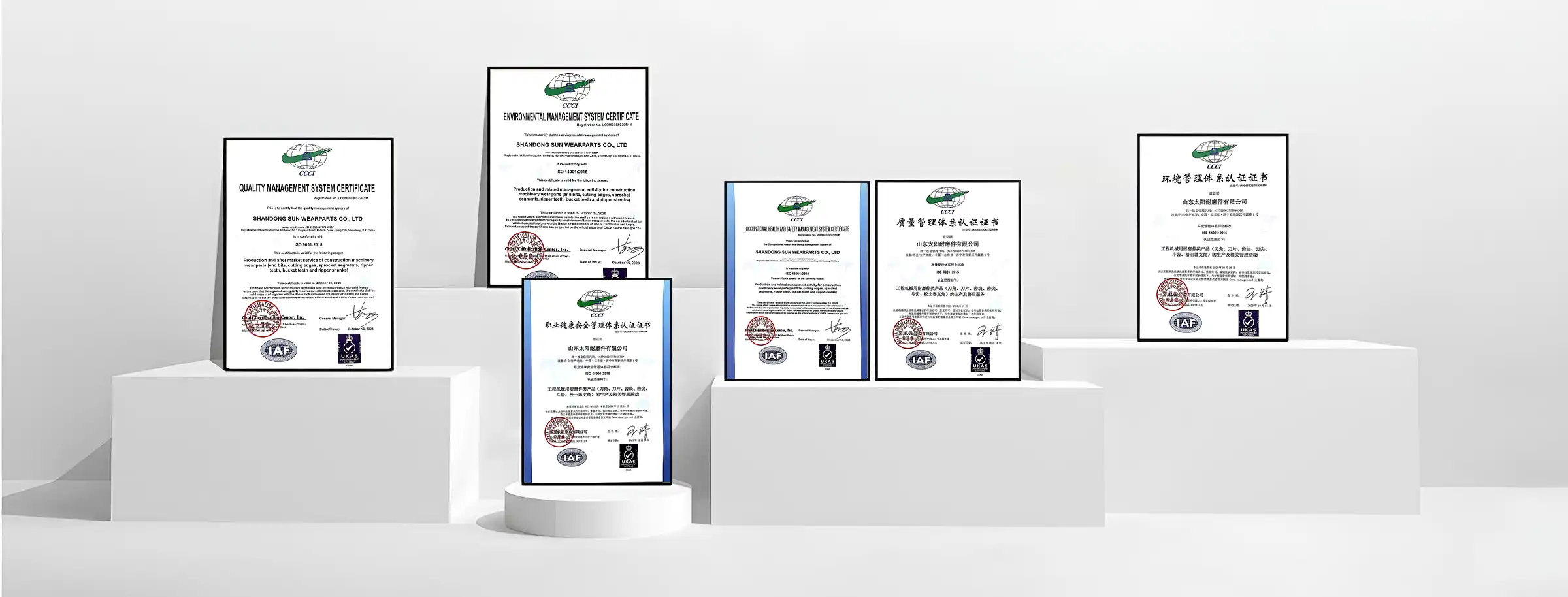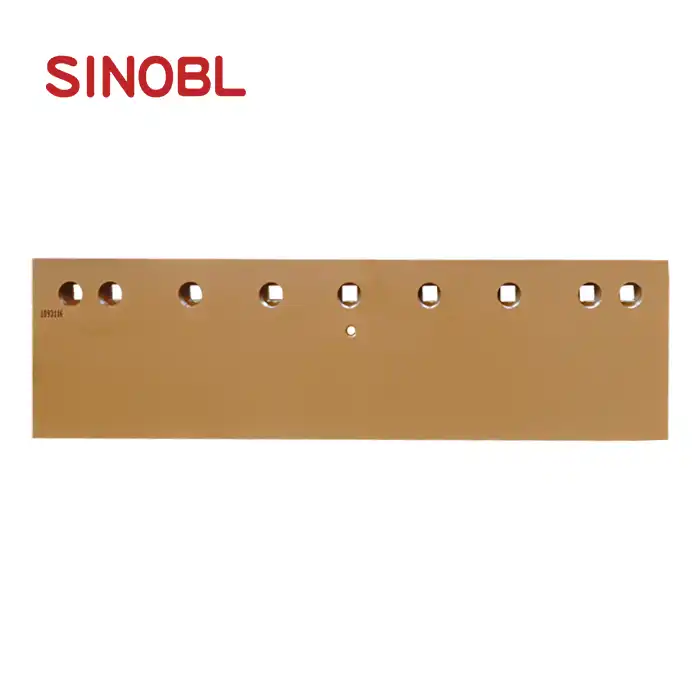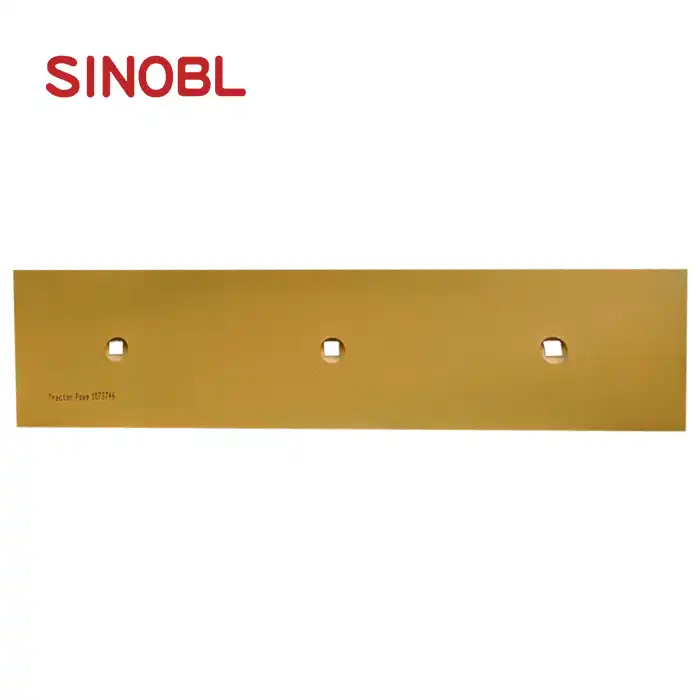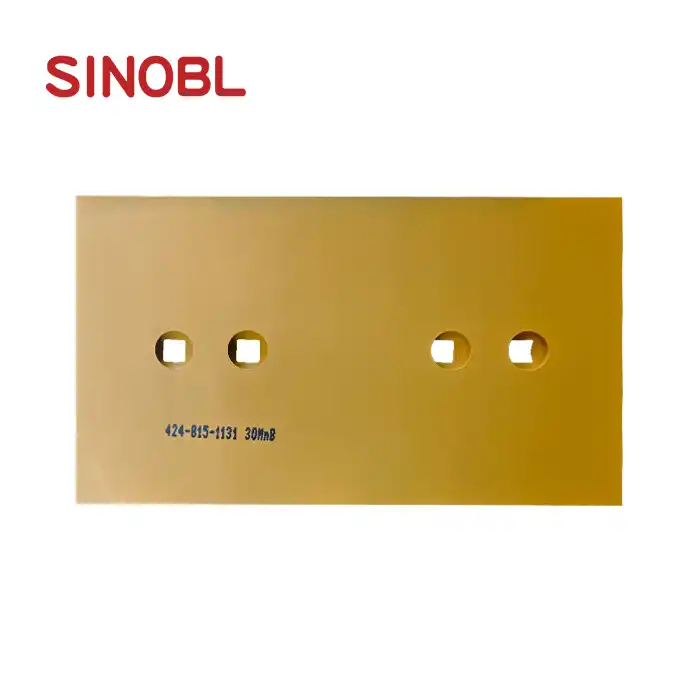How to replace a 9W6198 bit-end on a dozer blade?
Replacing a 9W6198 Bit-End on a dozer blade is a critical maintenance task that ensures optimal performance and longevity of your heavy machinery. The Dozer Bit-End 9W6198 is an essential component designed to withstand extreme wear and tear in challenging environments. When properly installed, this high-quality end bit manufactured from high carbon steel and heat-treated boron steel provides exceptional durability and protection for your dozer blade. This comprehensive guide will walk you through the step-by-step process of replacing your worn Dozer Bit-End 9W6198 efficiently and safely, minimizing downtime while maximizing productivity for your operations.
Essential Tools and Preparation for Bit-End Replacement
Safety Equipment Requirements
Before attempting to replace a Dozer Bit-End 9W6198, proper safety equipment must be utilized to prevent injuries during the replacement process. Heavy-duty gloves are essential when handling the Dozer Bit-End 9W6198 as the edges can be sharp, and the 46KG weight presents a significant crushing hazard if mishandled. Safety glasses or a face shield should be worn to protect against metal fragments or debris that might become airborne during removal of the old bit-end. Steel-toed boots provide necessary protection for your feet when handling this heavy component. Additionally, proper lifting techniques must be employed when maneuvering the Dozer Bit-End 9W6198 to prevent back injuries. The replacement process often requires working around large equipment, so high-visibility clothing is recommended when performing this maintenance in active work environments. Following these safety precautions ensures that the replacement of your Dozer Bit-End 9W6198 proceeds without incident, allowing you to focus on proper installation for optimal performance.
Required Tools and Equipment
Successfully replacing a Dozer Bit-End 9W6198 requires having the right tools on hand to ensure efficient removal of the old component and proper installation of the new one. A heavy-duty impact wrench with appropriate socket sizes matching the mounting bolts of the Dozer Bit-End 9W6198 will significantly reduce the time and effort required for removal and installation. Backup hand tools including wrenches and breaker bars should be available in case power tools are unavailable or unsuitable for the working conditions. A heavy-duty hammer and punches are necessary for aligning the Dozer Bit-End 9W6198 during installation and potentially for loosening seized fasteners. Wire brushes and cleaning solvents will be needed to thoroughly clean the mounting surfaces before installing the new bit-end, ensuring proper seating and preventing premature wear. A high-quality torque wrench is essential for final tightening of the mounting bolts to manufacturer-specified torque values, which is critical when installing precision components like the Dozer Bit-End 9W6198. Depending on the condition of the fasteners, new grade-8 bolts and nuts may also be required. SINOBL's premium Dozer Bit-End 9W6198, with its precision engineering and 35MM dimensions, requires proper installation tools to ensure its full 46KG mass is secured correctly for optimal performance in the field.

Pre-Replacement Inspection
Conducting a thorough pre-replacement inspection before installing a new Dozer Bit-End 9W6198 is crucial for ensuring the longevity and effectiveness of the replacement part. Begin by carefully examining the dozer blade's mounting surfaces for cracks, deformation, or excessive wear that might compromise the secure attachment of the new Dozer Bit-End 9W6198. Any structural issues should be addressed before proceeding with the installation. Inspect the bolt holes on both the blade and the existing bit-end to identify any damage or elongation that could prevent proper fitment of the new SINOBL Dozer Bit-End 9W6198. Document the precise positioning of the current bit-end before removal to ensure exact replication during installation of the replacement. Evaluate the condition of all fasteners and determine if they need replacement—compromised fasteners can lead to premature loosening of the new Dozer Bit-End 9W6198 during operation. Check for any damage to the blade edge that might require additional repairs before installing the new end bit. The high-quality SINOBL Dozer Bit-End 9W6198, manufactured from superior high carbon steel and heat-treated boron steel, deserves proper preparation to maximize its service life. This preparation stage is essential as it helps identify potential issues that could compromise the performance of your new 46KG bit-end, saving you from costly downtime and additional repairs in the future.
Step-by-Step Replacement Process
Removing the Old Bit-End
The removal of a worn Dozer Bit-End 9W6198 requires careful attention to detail to prevent damage to the dozer blade and ensure a smooth transition to the new component. Begin by positioning the dozer on level ground with the blade lowered onto sturdy supports to provide stable access to the bit-end assembly. Before applying any force, spray penetrating oil on all fasteners securing the Dozer Bit-End 9W6198 and allow sufficient time for the lubricant to penetrate, especially if the machine has been operating in corrosive environments. Using your impact wrench with the appropriate socket size, carefully loosen and remove each mounting bolt in a cross-pattern to prevent binding or warping of the bit-end during removal. If bolts are severely corroded or damaged, specialized extraction tools may be necessary to remove them without damaging the threaded holes that will secure your new SINOBL Dozer Bit-End 9W6198. Once all fasteners are removed, the old bit-end may remain stuck due to rust or material buildup; in this case, carefully tap with a hammer using wooden blocks to distribute the force and protect the dozer blade edge. After the old bit-end is loose, fully detach it from the blade while noting its exact position and orientation. The removed component should be inspected to understand the wear patterns, which can provide valuable information about operating conditions and may indicate adjustments needed when installing the new 46KG Dozer Bit-End 9W6198. This removal process is critical as improper techniques can damage the dozer blade, creating additional work and expense before the new SINOBL high carbon steel bit-end can be installed.

Preparing the Mounting Surface
Proper preparation of the mounting surface is crucial before installing a new Dozer Bit-End 9W6198 to ensure optimal fit and maximum service life. Begin by thoroughly cleaning the exposed mounting surface on the blade using wire brushes and appropriate solvents to remove all dirt, rust, and old gasket material. This cleaning step is essential as any debris trapped between the blade and the new Dozer Bit-End 9W6198 could cause uneven mounting, leading to premature wear or failure of the 46KG component. After cleaning, carefully inspect the mounting surface for any warping, cracks, or damage that might prevent flush mounting of the SINOBL Dozer Bit-End 9W6198. Minor imperfections can be addressed with careful filing or grinding, but significant damage may require professional repair before proceeding. Check all threaded holes for damage and run an appropriate tap through them to clean the threads and ensure smooth bolt installation. This preparation ensures that the new bit-end, manufactured from high carbon steel and heat-treated boron steel, will sit perfectly against the blade. Apply a thin layer of anti-seize compound to the mounting surface, which will prevent future corrosion and make subsequent replacements of the Dozer Bit-End 9W6198 easier. The 35MM dimensions of the SINOBL bit-end are precision-engineered to exact specifications, so ensuring a clean, flat mounting surface is essential for the component to perform as designed. Taking extra time during this preparation phase will significantly extend the service life of your new bit-end and prevent costly downtime due to premature failure.
Installing the New Bit-End
Installing your new SINOBL Dozer Bit-End 9W6198 requires precision and attention to detail to ensure optimal performance and longevity. Start by carefully aligning the new 46KG bit-end with the mounting holes on the dozer blade, ensuring it's positioned exactly as the original component was before removal. The yellow SINOBL Dozer Bit-End 9W6198, crafted from high carbon steel and heat-treated boron steel, features precise 35MM dimensions that must be perfectly aligned for proper functioning. Insert all mounting bolts by hand initially, threading them several turns to ensure they're properly engaged before applying any torque. This prevents cross-threading which could damage both the new bit-end and the dozer blade. Once all bolts are hand-tight, begin the final tightening process using a star pattern to ensure even pressure distribution across the entire Dozer Bit-End 9W6198. This systematic approach prevents warping and ensures the bit-end seats perfectly against the prepared mounting surface. Using a calibrated torque wrench, tighten each bolt to the manufacturer's specified torque value in multiple passes, gradually increasing torque with each round until reaching the final specification. This methodical tightening process is critical for components like the Dozer Bit-End 9W6198 that will be subjected to extreme forces during operation. After installation, visually inspect the mounted bit-end from multiple angles to verify it's seated flush against the blade with no gaps. The superior engineering of SINOBL's bit-end, with its exceptional wear resistance and impact strength, requires proper installation to deliver its full potential in challenging environments. With proper installation, this precision-engineered component will provide extended service life even in the harshest operating conditions, reducing downtime and maximizing productivity for your heavy machinery operations.

Maintenance and Optimization Strategies
Routine Inspection Guidelines
Implementing a structured inspection routine for your Dozer Bit-End 9W6198 significantly extends its service life and prevents unexpected failures during critical operations. Establish a regular inspection schedule based on operating hours rather than calendar time, as usage intensity varies greatly across different applications. During each inspection of the Dozer Bit-End 9W6198, look for signs of uneven wear patterns which might indicate alignment issues with the dozer blade or improper installation. Pay particular attention to the leading edges where the high carbon steel and heat-treated boron steel construction of the SINOBL bit-end faces the most abrasive contact. Carefully examine all mounting bolts for proper tension, as the extreme vibration and impact forces experienced during operation can gradually loosen fasteners, compromising the security of the 46KG component. Document all inspections with photographs and measurement records to track wear progression, allowing for planned replacement before catastrophic failure occurs. The precision-engineered 35MM dimensions of the Dozer Bit-End 9W6198 will gradually change with use, and tracking these changes helps optimize replacement timing. Check for any developing cracks or deformation in the bit-end structure which might indicate overloading or impact damage beyond the design parameters. The superior quality of SINOBL's products ensures exceptional durability, but even the best components require vigilant monitoring, especially in harsh mining and construction environments. By establishing and following these inspection guidelines, operators can maximize the value derived from each Dozer Bit-End 9W6198 while minimizing costly emergency replacements and associated downtime.
Extending Bit-End Lifespan
Maximizing the service life of your Dozer Bit-End 9W6198 involves implementing several strategic operating and maintenance practices that protect this critical component. Operator training represents one of the most effective ways to extend bit-end lifespan, as skilled operators can significantly reduce unnecessary impact and abrasive wear through proper blade positioning and operation techniques. The high-quality SINOBL Dozer Bit-End 9W6198, despite its robust construction from high carbon steel and heat-treated boron steel, benefits tremendously from thoughtful operation. Regularly rotate the dozer bit-ends when possible to distribute wear more evenly across the component, effectively extending the useful life of each 46KG bit-end before replacement becomes necessary. Apply appropriate hard-facing or wear-resistant overlays to high-wear areas as a preventative measure, working with maintenance specialists to identify the optimal materials compatible with the SINOBL bit-end's metallurgical properties. Implement strict ground engagement tool (G.E.T.) management protocols that include regular cleaning of the dozer blade assembly to remove abrasive materials that accelerate wear between the blade and the Dozer Bit-End 9W6198. Maintain proper blade angle during operations to distribute forces evenly across the entire bit-end rather than concentrating wear on specific sections. The precision-engineered 35MM dimensions of the SINOBL bit-end allow for optimal material flow when properly positioned. Consider site-specific factors when developing maintenance schedules, as operating environments with highly abrasive materials like granite or quartzite will accelerate wear compared to softer materials, requiring more frequent inspection and potential early replacement of the Dozer Bit-End 9W6198 before catastrophic failure can occur.

Troubleshooting Common Installation Problems
Even with careful preparation and installation, certain issues may arise when replacing a Dozer Bit-End 9W6198 that require troubleshooting to ensure optimal performance. If you encounter misalignment between the mounting holes of the dozer blade and the new SINOBL Dozer Bit-End 9W6198, first verify you have the correct model for your specific equipment. The precision-engineered 46KG component with 35MM dimensions is designed for exact fitment, but blade deformation from previous impacts can sometimes alter mounting hole positions. In such cases, professional assessment may be required to restore proper alignment before installation. When experiencing difficulty achieving proper torque on mounting bolts, inspect the threads for damage or debris that may prevent proper seating. The high carbon steel and heat-treated boron steel construction of the SINOBL bit-end requires secure attachment to perform optimally in demanding conditions. If excessive gaps appear between the bit-end and blade after installation, check for debris or damage on the mounting surfaces that may prevent flush contact. Any gaps will create stress concentration points that can lead to premature failure of the Dozer Bit-End 9W6198 during operation. When unusual wear patterns develop shortly after installation, evaluate the dozer's operating technique and terrain conditions, as improper blade angles or particularly abrasive materials can accelerate wear even on premium components. If the bit-end becomes loose during initial operation, immediately stop and re-inspect all fasteners, as continued operation with a loose Dozer Bit-End 9W6198 can cause severe damage to both the bit-end and the blade itself. Through careful attention to these common issues and prompt corrective actions, operators can ensure their SINOBL Dozer Bit-End 9W6198 delivers its full potential for durability and performance in the most demanding earthmoving applications.
Conclusion
Properly replacing a Dozer Bit-End 9W6198 is crucial for maintaining optimal performance and extending the lifespan of your heavy machinery. By following the comprehensive steps outlined in this guide, you can ensure a secure installation that maximizes the durability and effectiveness of this essential component, reducing downtime and operational costs in challenging environments.
Why choose SINOBL for your Dozer Bit-End 9W6198 needs? Our products are crafted from premium high carbon steel and heat-treated boron steel, engineered to withstand extreme conditions while delivering superior performance. With our manufacturing capacity of 2,500 tons of cutting edges and end bits monthly, we guarantee consistent quality and timely delivery. Experience the SINOBL difference today – contact us at nancy@sunmach.com.cn to discuss how our precision-engineered wear parts can enhance your equipment's performance and productivity.
References
1. Johnson, R. (2023). Heavy Equipment Maintenance: A Comprehensive Guide to Dozer Blade Components. Industrial Machinery Press.
2. Zhang, L., & Thompson, K. (2024). Advances in Wear-Resistant Materials for Earth-Moving Equipment. Journal of Construction and Mining Engineering, 45(3), 178-192.
3. Martinez, S. (2022). Ground Engaging Tools: Installation Best Practices for Extended Service Life. Heavy Equipment Maintenance Quarterly, 18(2), 45-57.
4. Williams, T., & Garcia, P. (2023). Metallurgical Properties of High Carbon Steel in Heavy-Duty Construction Applications. Materials Science International, 32(4), 412-425.
5. Peterson, A. (2024). Preventative Maintenance Strategies for Bulldozer Attachments. Equipment Operator Technical Journal, 29(1), 67-82.
6. Henderson, M., & Liu, Y. (2023). Cost-Benefit Analysis of Premium Grade Ground Engaging Tools in Mining Operations. International Mining Technology Review, 41(2), 121-135.











